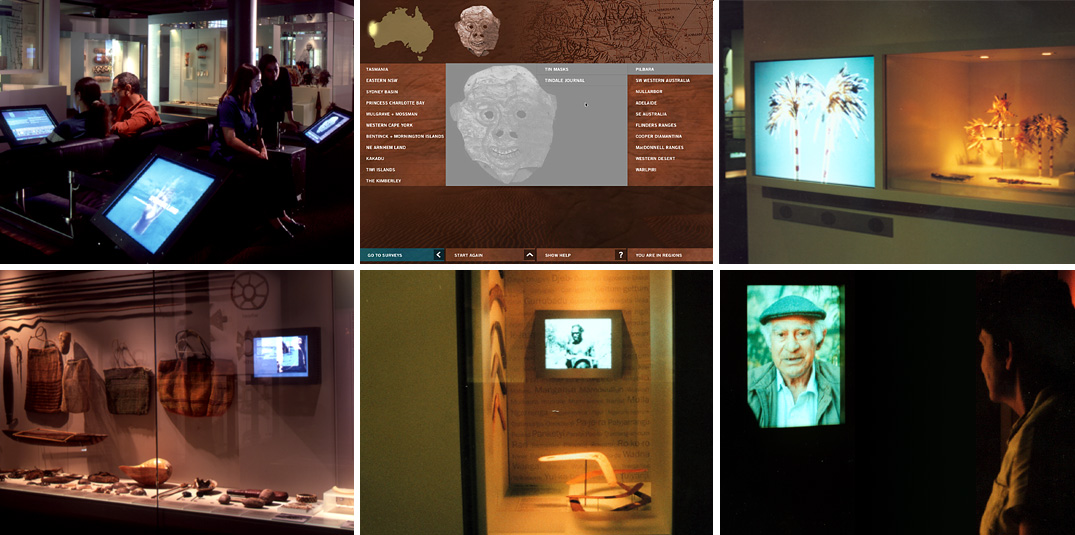
The central feature of this redevelopment was the creation of the Australian Aboriginal Cultures Gallery.
CDP worked with SAM anthropology curators, project manager Root Projects Australia and exhibition designers Freeman Ryan Design to develop and produce all multimedia for this outstanding gallery.
Introduction
Artist Fiona Macdonald was commissioned to work with the Anthropology Department photographic archives to produce an installation at the entrance to the galleries. I collaborated with Fiona and designer Jisuk Han of X-Squared Design to incorporate video media.
Using out-takes from the ‘Contemporary Voices’ video project (see below), I edited brief fragments of footage of the interviewees as they were listening to questions, waiting to begin or laughing with people off-camera.
Two LCD screens displaying the video are included in the final installation that comprises dozens of archival portrait images of Aboriginal people. In concert with the still photos, the video serves to demonstrate the fact of the continuity of the diverse indigenous cultures across Australia and the Torres Strait Islands.
Sound designer Nigel Frayne of Resonant Designs created a site-specific multi-speaker soundscape installed at the entrance, built from fragments of archival and contemporary audio relating to indigenous life and culture.
Speaking Land interactive
This innovative touchscreen interactive allowed visitors to explore over 1500 images, in-depth texts, 70 video and audio clips, and Quicktime VR media.
CDP and Freeman Ryan Design proposed a visitor experience concept based on the notion that museum visitors would better enjoy and use interactives if the environment for their use was social and comfortable, and the information provided was deep but easily navigable via a well-designed interface.
The built-form was designed by Freeman Ryan Design and constructed by specialist fabricator Machineability. The software, which ran on G3 Macintosh computers, was developed by a Clinic Design team led by Ian Hamilton.
CDP provided creative direction, technical systems design and executive production services to bring the project to fruition for the opening of the gallery in February 2000.
There were two ‘Speaking Land’ stations, each with three high-resolution touchscreens, one on each floor of the exhibition.
Contemporary Voices
The gallery displays are organised around two interpretive themes – regions and technologies. Aspects of Aboriginal life and culture within eight regions across the country are explored in detail.
An important component of each regional survey is the presentation of video portraits of Aboriginal people living within those regions today.
Working in consultation with each community, more than 60 individuals were video interviewed on location in their own country, speaking freely about their own lives. These interviews were edited in close consultation with Museum staff and presented in the gallery on high-resolution LCD monitors.
Each of nearly 100 video portraits was a self-contained movie that began with an image of landscape. This dissolved into an image relating to the story about to be told. The video portrait played, then concluded with another contextual image followed by a different landscape image which froze into a high-resolution still frame.
If a visitor was standing in front of the video monitor, or walked close by, the video came to life and another story was heard.
There were eight video portrait screens in the gallery, each presenting up to 14 different sequences.
Relatedness
Kinship and the laws regulating its expression are central to all Aboriginal and Torres Strait Islands cultures. This 20 minute display presented a series of filmic vignettes exploring the theme of ‘Relatedness’. It was housed within a separate exhibition space created specifically for the display, adjoining the main galleries.
Two video cubes flanked a large display case set into a wall at eye-level. The screens and display case were flush in the wall. Facing this array was a long bench seat with tall display cases on either side.
Original paintings on bark were displayed on the walls. As the synchronised videos played on the two screens, objects within the room – in the showcases and on the walls – were illuminated to connect them with the stories being presented.
A multi-speaker soundscape enhanced the spatial sense of the presentation.
Content for ‘Relatedness’ was developed with the generous assistance of Dr Peter Sutton.
Showcase Archival Screens
The SA Museum Anthropology Department collections include an extraordinary depth and diversity of media – from Edison wire and wax cylinder audio recordings to glass plate negatives, 16mm film, transparencies, prints, contemporary video formats and much more. Most of this media had only ever been seen or heard by those who created it, a few researchers and some museum workers.
New media technologies made the presentation of this material easier and it was important to the museum that visitors have the opportunity to experience some of these richly rewarding, irreplaceable media elements.
To this end, sequences of various historical media were edited together on a Macintosh based non-linear digital video edit system and pressed to DVD. The clips were presented on LCD monitors inside the object display showcases.
In some cases film sequences from the early 20th century show people working with or making the actual objects on display. In other instances, sequences of photographs are examined to reveal their detail.
Additionally, a plasma panel is set into a feature wall on each floor. One displays archival media relating to hunting, gathering and eating, while the other presents a visual essay on the differing rock art styles found across Australia.
Indigenous Information Centre
This resource centre provided a range of activities and services including supervised access to the Museum’s and other indigenous family history projects.
The ‘Speaking Land’ interactive was accessible, as well as CD-ROMs from various sources.
A multi-input plasma panel was fitted in a custom cabinet for display of changing video titles, to show satellite TV broadcast from Australian and Pacific islands indigenous TV stations, and for use in tele-conferencing.
gary warner 2012
———
Services
concept development
design liaison
executive production
creative direction
tenders and contracting
technical systems design
hardware procurement
installation supervision
commissioning
Contract Period
Sep 1998 — Mar 2000